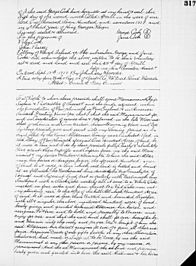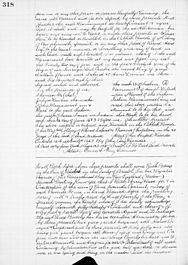John Alderman facts for kids
John Alderman, also known as Isaac and Antoquan, was a Wampanoag man. He was a "praying Indian", which meant he was a Native American who had become Christian. Alderman is known for his role in ending King Philip's War in 1676. During this war, he shot and killed the Native American leader Metacomet, also known as King Philip. Alderman was part of a group led by Captain Benjamin Church, an English colonist.
Alderman was a leader, or subsachem, in the Westport and Dartmouth areas of what is now Bristol County, Massachusetts. He was called "Alderman" because he was seen as a close helper and advisor to King Philip. However, he later joined the English side.
Joining the English Side
Alderman decided to switch sides during King Philip's War. This happened after King Philip caused harm to Alderman's brother. After this event, Alderman joined Captain Benjamin Church. Church was an English colonist who lived in nearby Little Compton.
Church was known for preferring to use Native American soldiers to fight other Native Americans. He later led several trips to Maine during Queen Anne's War. He also used Native American soldiers on these trips.
Some historical writers, like Cotton and Increase Mather, wrote about Alderman. They said he was connected to Weetamoo. She was a powerful female leader, or squaw sachem, of Pocasset. This area is now Fall River, Massachusetts, and Tiverton, Rhode Island. Alderman's land was in the Pocasset area. A deed from Sachem Mamanuah mentioned Alderman living near Punkatest Pond. This pond is now called Nonquit Pond in Tiverton, Rhode Island. This area was close to the Pocasset village.
Life After the War
After King Philip's War, John Alderman took the name Isaac. He became a Native American minister in Coxit, Dartmouth. He had a son who was named Isaac Isaac, following the naming traditions of that time. His son was a witness when Sachem Mamanuah gave Alderman 100 acres of land.
Alderman also had a wife named Kate. We know this from a land record in Portsmouth, Rhode Island. For his service during the war, Alderman received 100 acres of land in Little Compton from Mamanuah. He later sold this land to an English colonist. This sale was recorded in Portsmouth, Rhode Island, because the English colonist was from there.
Alderman also visited Portsmouth with Benjamin Church for another reason. They helped arrange for a Native American woman and her son to work for a local weaver. The woman was being punished for supporting Metacomet during the war. She was set to work for William Wodell, a weaver, for the rest of her life.
His Names and Family
While many people know him as Alderman, his original Wampanoag name is mentioned only once. It appears in the records of Little Compton. The name "Isaac" also shows up in a land record in Barnstable County. This suggests he might have been held in a certain area after King Philip's War.
Alderman's son might have later used the names "Isaac Simon" or "Isaac Crocker" after his father passed away. The surname "Isaac" was also used by Native Americans from Martha's Vineyard. Some of these people later moved to the Brothertown Community in upstate New York.
In 1800, a Native American man named James Thomas died in Milton, Massachusetts. He claimed to be Alderman's grandson. James Thomas was 94 years old when he died, born in 1706. So, his claim to be Alderman's grandson could be true. The Thomas family was linked to the Titticut Native American village in Middleboro. A Native American named James Thomas even gave land there for a meeting house.



